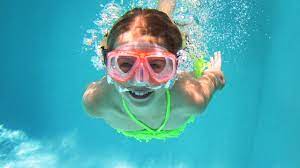Colours change to a surprising degree when submerged underwater, so what you and your children wear in the water can make a difference in an emergency.
It is a beautiful evening in early summer, and instead of sitting on the patio, enjoying the sunshine, I am on my computer, scrolling through image after image of swimsuits for my toddler. The options seem endless. Ruffled and white with a pattern of blue seashells and a matching, wide-brimmed hat. Sky-blue and short-sleeved, embellished with an embroidered mermaid. Strapless with pastel rainbow stripes and a little bow on each shoulder.
The swimsuits are adorable. They look comfortable. Many of them are even made from fabric that is rated at SPF 50+. There is only one problem: if, God forbid, my toddler were to wind up in the water unexpectedly, any of these colours, and prints, would make her extremely difficult to see.
While this might sound like parent paranoia, the statistics show otherwise. In the US, for example, drowning is the leading cause of death for children aged one to four. For children ages five to 14, it's the second leading cause of accidental death, after car accidents. Non-fatal drowning accidents are even more common: for every child who dies of drowning, another seven receive emergency care. Even when drowning isn't fatal, it can cause a host of health problems, including brain damage.
Of course, it isn't just children who this affects. Every year, the World Health Organization (WHO) reports, around 236,000 people fatally and accidentally drown – accounting for nearly 8% of all injury-related deaths globally every year.
Both the WHO and the US's Centers for Disease Control and Prevention (CDC) report that there are factors that make drowning less likely, such as having taken swimming lessons; having proper fencing around home swimming pools (where most drownings for young children occur); and ensuring constant supervision of children near water (among infants, tragically, two-thirds of drowning deaths occur in bathtubs, the CDC says).
But when a child (or adult) does go missing near water, every second matters. And there's another factor that some experts say we should add to those above: wearing colours and fabrics that make us more visible in the water.
Natalie Livingston has worked as a lifeguard, lifeguard instructor, waterpark manager and pool and spa inspector; she is also the co-founder of US company Alive Solutions, which provides public water safety education, training and resources. From her work in water safety, she'd always known that certain colours were more visible than others. But a few years ago, she decided to test them properly.
"Back in 2019, I was with my kids around water a lot, and I was seeing all these kids in darling swimsuits that were not great colours – the kids would jump in the water and just disappear," she says. "So we decided to actually test colours and see what would be the most visible in different environments."
They put various colours of fabric, from lipstick red to fluorescent green, under three feet of water in different conditions – against a dark-coloured pool bottom, a light-coloured pool bottom, and in a lake, with water both calm versus agitated. When the water was agitated – as it would be in a crowded pool, say, or under the waves of the ocean – many of the colours became extremely difficult to see. (While a camera senses light differently than our eyes, Livingston says that the test results support what she and others she works with have noticed as lifeguards and swim instructors).
The worst performers were blues, greys, and whites. Dark colours also performed poorly. And while not all pastels were tested, it's likely they would similarly lack visibility. One reason for this is because water absorbs and scatters light differently from in the air, causing many colours to become desaturated to our eyes. This is because water readily absorbs longer wavelengths of light and quickly become filtered out with increasing depth. It means colours at the red end of the spectrum very quickly become difficult to spot when submerged more than a few feet of water and are completely absent from the deep ocean.
One very visual experiment conducted by educational broadcaster PBS Learning demonstrates just how quickly this can happen in the sea – at around 16ft (4.8m) underwater, an object that was bright red on the surface takes on a blue tone even when viewed at close range. From the surface, things become even harder. "In a white pool, the darker colours looked like shadows, and in the murky brown lake, the lighter colours looked like a cloud reflection," she says.
Any agitation on the water surface changes perception, too. "Water is not like looking through air or a window – it can be very distorting with just the tiniest of surface movement," says Livingston.
That means that light, dark, and neutral tones are less than ideal colours for anyone wanting to be easy to spot in the water. Even some bright, primary shades didn't do very well: in agitated water, red looks dark, easily mistaken for a shadow, as does bright blue. These are all colours that, in my admittedly completely unscientific study of online brands, are among the most popular for children's swimwear.
Yet the most visible colours – neon pink and neon orange, followed by neon green and yellow – can be remarkably difficult to find, I found.
More recently, in May 2023, Alive released another test. This one looked at whether solids versus prints made a difference – key to know, since so many swimsuits feature fun prints and patterns. They found that the best visibility came from solid colours. Next best were very small printed patterns. But for larger prints, even if the base colour was bright, a print still affected visibility. When patterned with white stripes, fluorescent orange – which was the most visible solid colour – looked more like a reflection in the water. With dark stripes, it all but disappeared.
This perhaps shouldn't be surprising if we look at the natural world: many fish use stripes and patterns to camouflage themselves underwater. The patterns serve to break up their outline and make them harder to spot.
Given the results of both tests, Livingston says, she would recommend neon colours, either solid, colour-blocked, or with small prints.
There seem to be more options for such suits today than even a few years ago, Livingston says, perhaps because word is getting out to manufacturers – or perhaps because the garish 1980s trends for neon are coming back in style.
Still, finding these kinds of suits for children – or for adults – remains difficult. "Swimsuit manufacturers have been slower getting on board with this information. Many people say it is very hard for them to find neon swimwear," she says.
I'm one of them. After more than an hour of searching across the internet, I found just two solid, neon swimsuits: a neon-orange one-piece and a fluorescent-yellow sport bikini. I also bought a couple of SPF 50+ rasher vests in neon colours, though I had to buy short sleeves – since the only colours available in the long-sleeved versions were… different shades of blue.
More about:
















































